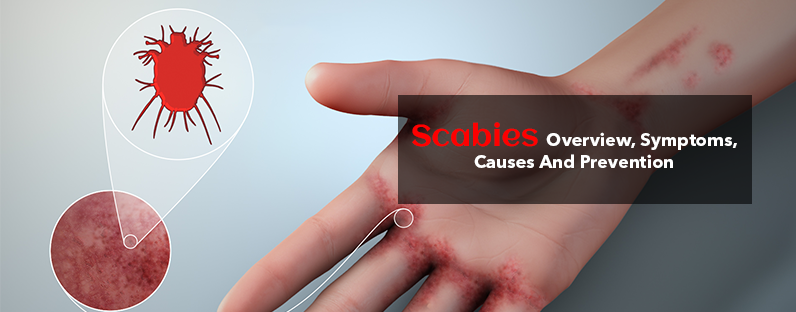Scabies- overview, symptoms, causes and prevention
Overview
Scabies is an itchy skin condition which is caused by a tiny burrowing mite known as Sarcoptes scabies. Intense scratching takes place at the location where the mite burrows. Especially at night, the urge to scratch can be intense.
Scabies is infectious and may spread quickly by close physical contact in family, child care community, school class, nursing home or jail. Since the scabies is so infectious, doctors often prescribe medication for whole families or groups of touch.
Scabies can be readily treated. Medicines applied to your skin kill the mites that cause scabies and their eggs. But you may still have some itching for several weeks after treatment.
Symptoms
Scabies signs and symptoms include:
- Itching, most extreme and mainly worse at night
- Thin, irregular burrow tracks consisting of tiny blisters or bumps on the skin.
Normally, burrows or tracks occurs in skin folds. However, though almost any part of the body may be involved, scabies is most often found in adults and older children:
- Between the fingers
- In the armpits
- Around the waist
- Along the insides of the wrists
- On the inner elbows
- On the soles of the feet
- Around the breasts
- Around the male genital area
- On the buttocks
- On the knees
In infants and young children common infestation sites typically involve the following:
- Scalp
- Palms of the hands
- Soles of the feet
If you had scabies before, it may cause signs and symptoms within a few days of exposure. If you have never had scabies, the signs and symptoms can take as long as six weeks to begin. Even, you can spread scabies even though you have no signs or symptoms yet.
When to see a doctor
If you have signs and symptoms which can indicate scabies, speak to your doctor.
Many skin conditions, such as dermatitis or eczema, are associated with itching and small bumps on the skin. Your doctor will help you find out the precise cause and make sure you get adequate care. Preparations for bathing and over-the-counter may ease itching but will not remove scabies.
Causes
Microscopic is the eight-leg mite that causes scabies in humans. The female mite burrows just below your skin and creates a tunnel where eggs are deposited.
The eggs hatch and the mite larvae work their way to your skin’s surface, where they grow and can spread to other areas of your skin or other people’s skin. Scabies itching results from the allergic reaction of the body to the mites, their eggs and their waste.
Physical connection and, less often, cloth or bed-sharing with an infected person will spread the mites.
Animals and humans both have their distinct types of mites affected. Growing species prefers one particular type of host and does not live long away from the host they prefer.
Human people may have a temporary skin reaction from contact with the mite of animal scabies. But it is unlikely that people would acquire full-blown scabies from this source, because they may be by contact with the human scabies mite.
Complications
Vigorous scratching can break your skin and give rise to a secondary bacterial infection, such as impetigo. Impetigo is a superficial infection of the skin that’s caused most often by staph (staphylococci) bacteria or occasionally by strep (streptococci) bacteria.
A more serious type of scabies, called crusted scabies, can affect certain high-risk groups, including:
- People with chronic health conditions that weaken the immune system, such as HIV or chronic leukaemia
- People who are very sick, such as people in hospitals or nursing homes
- Older people in nursing homes
Crusted scabies, also known as Norwegian scabies, appear to make the skin crusty and scaly, and affect large areas of the body,
Usually, someone with scabies has around 10 to 15 mites. In comparison, someone with crusted scabies can get millions of mites infested.
Prevention
Take these measures to avoid re-infestation and to avoid dissemination of the mites to others:
Clean all linens and garments: Use warm, soapy water to wash all sheets, towels and bedding used within 3 days before treatment begins. Dry over high heat. You can’t wash the dry-clean items at home.
Starve the mites: Consider putting things that you cannot wash in a sealed plastic bag and leave them in an out-of-the-way location for a few weeks, such as in your garage. Mites die after some days without food.
